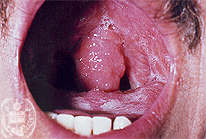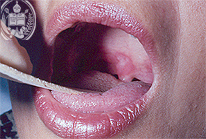|

Fig.11-A1
Mucocutaneous Leishmaniasis
A 27 -years old man from Socopó, a town in the West of the State Barinas comes to an Ear-Nose-Throat specialist presenting nasal ardor and bleeding together with a mucous secretion and hoarseness. The patient had been treated with several antibiotics without any improvement. Looking at the mucosa of the oral cavity a marked diffuse reddening is found, accompanied by several slightly elevated foci involving the palatal velum, the uvula and the soft palate.
|
|

Fig.11-B1
Secondary Syphilis
A 23 years -old woman from Barinas showed a painful inflammation of the palate, preferably of the uvula which existed only since a few days. The patient complained of headaches, fever and nausea. In smears taken from the affected mucosa neither fungi nor parasites were found. In the lymph of the mucosal areas and from the lymphnodes moving Trepanoma pallidum organisms could be seen in the darkfield. Furthermore the VDRL test was positive. The patient reported later a small painless ulcer at the introituses vagina 10 weeks ago which had healed spontaneously. Therefore the diagnosis of a secondary syphilitic pharyngitis, so called "plaque muqueuse", could be made.
|